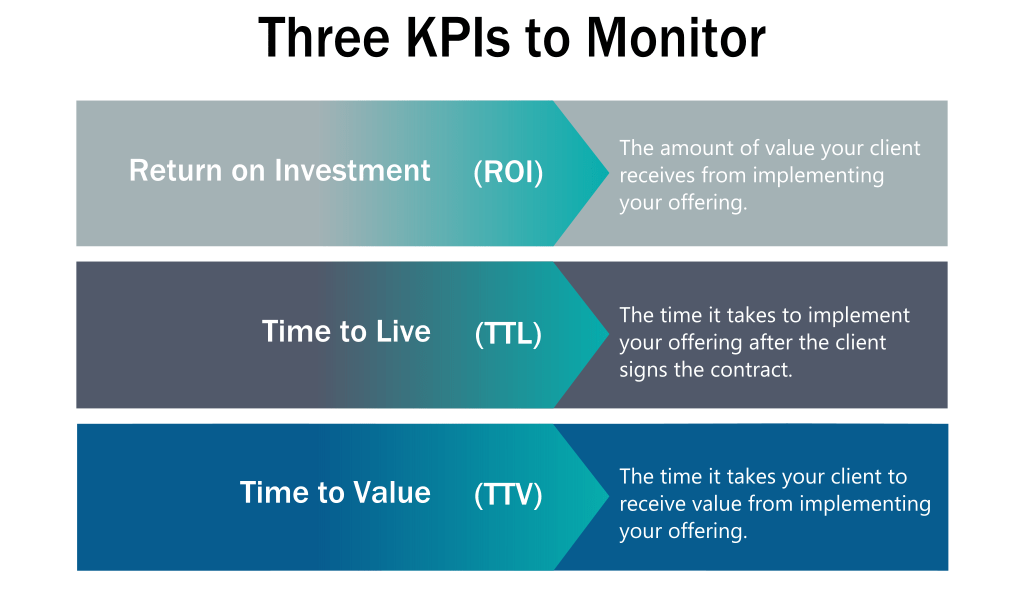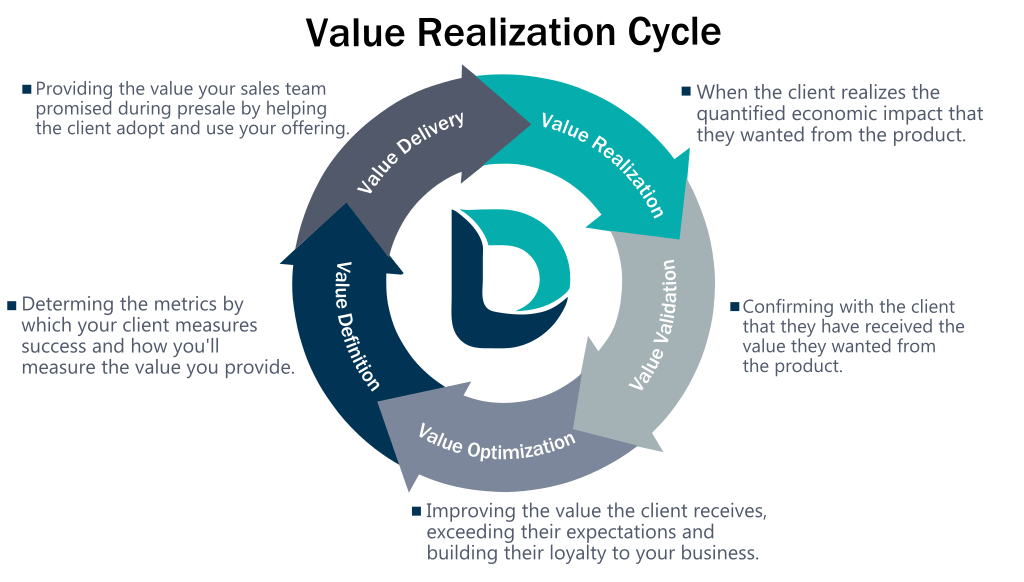How to Measure Value Realization: Key Metrics to Focus On

You know the unique value you offer as a company — but do your customers and clients know it?
Your clients may not be fully aware of the impact your solutions have on their business. This could happen because you lack a plan to regularly communicate that value. As a consequence, customers may have a distorted perception of what you are able to offer them. This can lead to low customer satisfaction and high customer churn.
The solution? Prioritize and accurately measure value realization among your clients. This article will show you how value realization can affect your business and guide you in identifying the metrics that you can concentrate on to boost your success.
Understanding Value Realization
At its heart, value realization is simple. When customers start looking for solutions to a problem, they have an inherent value expectation in mind. They then try different solutions until they find one that generates a level of value that has a positive impact on their business.
Value realization is much more than just an understanding that a product or service has worth, though. It is a specific revelation about the value your offering provides to a specific customer based on their strategic goals. It is the moment when the customer feels validated in their purchase decision because they clearly understand the economic impact that their decision has had on their organization.
Value realization is every customer’s goal. It is satisfying for several reasons:
- The problem they sought to resolve is solved, satisfying the client and relieving their pain.
- The client feels validated for making the correct choice.
- The client receives positive feedback from members of their organization for having determined an effective solution.
Measuring how your customers realize value is vital to delivering value realization. Learning how your customers engage with your product and what generates customer satisfaction helps you win and more effectively maintains clients.
Why Is Value Realization Important?
When customers can realize the full value of their investment, they are more likely to be satisfied with the product or service, renew their contracts, and recommend the company to others. This can lead to increased customer loyalty, reduced churn, and improved revenue and profitability.
On the other hand, when customers cannot realize the expected value, they may become dissatisfied, disengaged, or even switch to a competitor. This can lead to lost revenue, decreased market share, and a damaged company reputation.
By focusing on value realization, businesses can differentiate themselves from their competitors, build trust and loyalty with their customers, and achieve long-term growth and success. This process involves not only delivering the promised value proposition but also continuously monitoring and optimizing the customer experience to ensure ongoing value and satisfaction.
Measuring Value Realization
Value realization is achieved in multiple ways. Your company needs to define the value realization metrics that it wants to monitor. It is important to note that a value realization metric is not the same as a key performance indicator (KPI). To appropriately measure your company’s value realization achievements, you need to set both.
In general, metrics are broad measurements, while KPIs are in-depth data that relate to specific defined goals. Metrics let your business track general performance. KPIs help you track your team’s or organization’s performance concerning specific, critical business objectives.
For example, a common metric for online businesses is total website traffic during a specific period. Meanwhile, a standard KPI is the amount of traffic on specific landing pages.
Both sets of data are essential. Your KPIs help you monitor the critical elements of your value realization strategy, while your metrics let you follow broader trends that may affect your KPIs.
By providing a few key details about your company and current sales process, you can quantify potential revenue benefits, cost savings, and net recurring revenue opportunities. Check out our Value Calculator right away.
Defining Your Value Realization Metrics by Customer
To measure your customers’ value realization, you need to define what metrics to track. Unlike other elements of business data analytics, value realization metrics are highly subjective — the value you believe provide to customers needs to incorporate the opinions and sentiments about your product held by the customers themselves, in addition to the quantitative impact your solutions deliver.

Three important KPIs you should be sure to monitor to improve customer value realization:
Return on Investment (ROI)
Return on investment (ROI) is a financial metric used to evaluate the profitability and efficiency of an investment in relation to its cost. In the context of B2B products and services, ROI refers to the financial return that a customer expects to receive from their investment in a product or service.
B2B customers typically consider multiple factors when evaluating the ROI of a product or service, including the upfront cost, the potential revenue or cost savings, the payback period, and the risk of the investment. They may also consider qualitative factors, such as the impact on productivity, competitiveness, or customer satisfaction.
The more ROI the customer experiences, the greater their sense of value realization will be. After all, they are seeing the value in dollars and cents on their bottom line.
Time to Live (TTL)
Time to live (TTL) is the time it takes to implement your offering after the client signs the contract. This is different from “time to value (TTV)” because we are not measuring how long it takes for the customer to realize the full value of your offering. That could take months or even years.
TTL, rather, is just the time it takes to ramp up. Think of it as the time it takes for the plane to take off and get underway, not the time it takes to arrive at the destination. Anyone who has taken a long plane flight knows that takeoff is an achievement of its own!
TTL is important to value realization because it satisfies the customer’s desire to feel they made the right decision. If it takes forever for things to start “happening,” they may start to question their buying decision, thus undermining their value realization. In fact, slow TTL may blunt their value realization — even if your company delivers on every value promise!
Time to Value (TTV)
Time to value (TTV) refers to the amount of time it takes for a customer to realize the full value of their investment in a product or service. As you can guess, the faster the TTV, the sooner your customer achieves full value realization.
TTV is an essential consideration for B2B customers who expect to see a return on investment as quickly as possible. The shorter the TTV, the faster customers can realize the benefits of their investment and justify the value of their purchase.
Factors that could affect the TTV of B2B products and services include the ease of implementation, the level of customization required, the training and support needed, and the complexity of the product or service.
Setting Your Company Up for Optimal Value Realization
It is important to determine how you will measure value from the start. This definition process should begin before you finalize any sale, and it should stay consistent throughout the client lifecycle.
During the presale process, your sales team works with prospects to understand their needs, sell them on your service's or product’s value, and promise them specific results. This is the perfect time to work with potential customers to identify the metrics and KPIs that you should prioritize. Your sales team can ask four critical questions during the presale period:
- What are the key milestones the client wants your offering to achieve?
- What will the client consider a successful implementation of your offering?
- How does the client’s supervisor define successful performance?
- What elements of your offering are most important to the client?
The answers to these questions will help you identify the metrics and KPIs that matter. For example, suppose the client wants to achieve a specific percentage increase in production. In that case, production speed and performance will be essential metrics. Similarly, you can track the time it takes to implement the features your client considers most important.
Since each company’s strategic initiatives are unique, expect their value realization metrics to be unique as well, especially when considering different industries, company sizes, and many other factors. It’s worthwhile to track myriad types of value for different segments so you can maintain similar levels of service across your entire customer base. Using a value realization system can help you easily monitor the value of all your offerings in one place.
The Continuous Value Realization Cycle
The value realization process is only just beginning once you have identified your initial value metrics. In fact, the process should never really end — it’s an ongoing cycle. The continuous value realization cycle allows you to regularly update your solutions to fit your clients’ needs and maintain their satisfaction with your services. The cycle has five steps:
1. Value Definition
Value definition involves identifying and defining the value proposition of a product or service for customers. It requires understanding the specific needs and desires of the target market and crafting a solution that addresses those needs in a unique and compelling way.
Value definition is important because it sets the foundation for all other aspects of the business, including product development, marketing, sales, and customer service. It ensures that the company is creating products or services that meet the needs of its customers and are differentiated from those of its competitors.
2. Value Delivery
Value delivery refers to the process of providing and delivering the promised value proposition of a product or service to customers. It involves ensuring that customers receive the benefits they expected and that they are satisfied with their investment.
Value delivery encompasses all aspects of the customer experience, from the initial purchase to ongoing support and service. It encompasses the quality of the product or service, the ease of implementation, the level of customization, and the level of support and training provided to customers.
Value delivery is critical because it directly affects customer satisfaction and loyalty. When customers receive the promised value and have a positive experience, they are more likely to renew their contracts, recommend the company to others, and continue to do business with the company in the future.
3. Value Realization
The core topic of this article, value realization refers to the process by which customers experience and extract the benefits of a product or service. It involves the successful delivery of the promised value proposition and the achievement of the customer's goals and objectives.
Value realization directly relates to customer satisfaction, retention, and profitability. When customers can realize the full value of their investment, they are more likely to be satisfied with the product or service, renew their contracts, and recommend the company to others.
4. Value Validation
Value validation means you verify with the customer that they received the value they expected — or the value you think you delivered and meant to deliver. Without value validation, you could be failing to live up to the customer’s standards and not even know it. You don’t want to be the company that thinks it’s knocking it out of the park … when in reality, customers are underwhelmed.
Value validation can be performed through customer surveys, focus groups, analytics, and in-product user-generated feedback.
5. Value Optimization
Value optimization means maximizing the perceived value of a product or service to customers — usually based on customer feedback — while minimizing costs and resources. It involves finding the optimal balance between delivering value to customers and achieving profitability and sustainability for the business.
Value optimization allows businesses to take the feedback they got from the value validation process and use it to maximize their return on investment while delivering the highest possible value to customers. Smart companies continuously assess and refine the value proposition, thereby improving the customer experience, while finding ways to reduce costs and increase efficiency.
Several strategies can be used to determine value optimization, including product differentiation, pricing strategies, process optimization, and customer segmentation. These strategies allow businesses to tailor their value proposition to different segments of the market, price their products or services effectively, and optimize their operations to reduce costs and improve efficiency.
Value Realization Over Time
It is important to note that your clients’ needs will change over time. As technology and markets change, your clients will begin to measure success by different metrics. New KPIs could become important. When you start optimizing value, check in with your clients to ensure that you are still operating under the same shared perceptions of success.
Value Realization Begets Lifetime Customers
Helping your clients understand the value they receive from your offerings is essential to keeping them as clients. When you know which metrics and KPIs to watch, you can show your customers exactly how much your business is helping them. Clients who understand your product’s or service’s true worth will remain loyal for life.
One method to monitor the value realization metrics that matter is to use a solution like ValueCloud®.
DecisionLink is the industry leader in cloud-based customer value management. You can directly show your current clients how you’ve helped them meet goals and improve performance.
Its comprehensive value realization capabilities can help you build client loyalty, reduce churn, and provide your customers with the service they want.
To learn more about Value Realization, read "The Roadmap to Value Maturity," or watch the webinar recording of "Selling with Metrics that Matter" for a more in-depth conversation on which metrics will guide your organization's success, and how to use them.

 ValueCloud
ValueCloud
.png?width=118&height=76&name=Rectangle%20(3).png) ValueCloud Ignite
ValueCloud Ignite
.png?width=92&height=92&name=Rectangle%20(4).png) Free Assessment
Free Assessment
.png?width=100&height=100&name=Rectangle%20(5).png) Watch a Demo
Watch a Demo
.png?width=82&height=96&name=Rectangle%20(6).png) Value Calculator
Value Calculator

.png?width=62&height=51&name=Group%2010%20(1).png) Marketing
Marketing
 Sales
Sales
 Customer Success
Customer Success
 Engage Prospects
Engage Prospects
 Win Deals Faster
Win Deals Faster
 Retain Customers
Retain Customers
.png?width=62&height=62&name=Rectangle%20(8).png) Adopt and Scale
Adopt and Scale
.png?width=54&height=54&name=Rectangle%20(9).png) Cybersecurity
Cybersecurity
 Healthcare
Healthcare
.png?width=54&height=54&name=Rectangle%20(10).png) IT & Software
IT & Software





